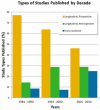A systematic review of global publication trends regarding long-term outcomes of ADHD
- PMID: 22279437
- PMCID: PMC3260478
- DOI: 10.3389/fpsyt.2011.00084
A systematic review of global publication trends regarding long-term outcomes of ADHD
Abstract
There is increased global recognition of attention deficit hyperactivity disorder (ADHD) as a serious medical condition with long-term consequences. Although originally conceived of as a childhood disorder, ADHD is being increasingly recognized in adults. Individual geographic regions may have specific interests and objectives for the study of ADHD. A systematic review of long-term outcomes (LTOs) in ADHD was conducted to evaluate research on ADHD LTOs on a global scale. Studies that were at least 2 years in duration were examined. A total of 351 studies were identified in the final analysis. We identified nine outcomes of interest and classified studies by specific geographical regions, age groups studied and study design by region and over time. Published studies of LTOs in ADHD have increased in all geographical regions over the past three decades, with a peak number of 42 publications in 2008. This rise in publications on ADHD LTOs may reflect a rise in global interest and recognition of consequences and impairment associated with ADHD. Although many world regions have published on ADHD LTOs, the majority of studies have emerged from the US and Canada, followed by Europe. While investigators in the US and Canada were predominantly interested in drug addiction as a LTO, European researchers were more interested in antisocial behavior, and Eastern Asian investigators focused on both of these LTOs as well as self-esteem. Geographical differences in the focus of ADHD LTO studies may reflect regional variations in cultural values. Proportionally fewer prospective longitudinal studies and proportionally more retrospective and cross-sectional studies have been published in more recent decades. Finally, more studies focusing on ADHD in adolescents and adults have been conducted in recent years, and particularly adolescents in Eastern Asia. These changes in basic study design may reflect an increase in the recognition that ADHD is a lifetime chronic disorder. This systematic review analysis of publication trends in ADHD LTOs reflects geographically based interests that change over time.
Keywords: ADHD; TDAH; attention deficit; hyperactivity; hyperkinetic.
Figures





Similar articles
-
Immediate-release methylphenidate for attention deficit hyperactivity disorder (ADHD) in adults.Cochrane Database Syst Rev. 2021 Jan 18;1(1):CD013011. doi: 10.1002/14651858.CD013011.pub2. Cochrane Database Syst Rev. 2021. PMID: 33460048 Free PMC article.
-
Practical considerations for the evaluation and management of Attention Deficit Hyperactivity Disorder (ADHD) in adults.Encephale. 2020 Feb;46(1):30-40. doi: 10.1016/j.encep.2019.06.005. Epub 2019 Oct 11. Encephale. 2020. PMID: 31610922 Review.
-
Trends in attention-deficit hyperactivity disorder medication use: a retrospective observational study using population-based databases.Lancet Psychiatry. 2018 Oct;5(10):824-835. doi: 10.1016/S2215-0366(18)30293-1. Epub 2018 Sep 13. Lancet Psychiatry. 2018. PMID: 30220514
-
Twenty-Year Trends in Diagnosed Attention-Deficit/Hyperactivity Disorder Among US Children and Adolescents, 1997-2016.JAMA Netw Open. 2018 Aug 3;1(4):e181471. doi: 10.1001/jamanetworkopen.2018.1471. JAMA Netw Open. 2018. PMID: 30646132 Free PMC article.
-
A Phase III, Randomized, Double-Blind, Placebo-Controlled Trial Assessing the Efficacy and Safety of Viloxazine Extended-Release Capsules in Adults with Attention-Deficit/Hyperactivity Disorder.CNS Drugs. 2022 Aug;36(8):897-915. doi: 10.1007/s40263-022-00938-w. Epub 2022 Jul 27. CNS Drugs. 2022. PMID: 35896943 Free PMC article. Clinical Trial.
Cited by
-
A phenome-wide association study of polygenic scores for attention deficit hyperactivity disorder across two genetic ancestries in electronic health record data.Am J Med Genet B Neuropsychiatr Genet. 2022 Sep;189(6):185-195. doi: 10.1002/ajmg.b.32911. Epub 2022 Jul 15. Am J Med Genet B Neuropsychiatr Genet. 2022. PMID: 35841203 Free PMC article.
-
Pathway to care and clinical profile of children with attention-deficit hyperactivity disorder in New Delhi, India.J Family Community Med. 2018 May-Aug;25(2):114-119. doi: 10.4103/jfcm.JFCM_142_16. J Family Community Med. 2018. PMID: 29922112 Free PMC article.
-
Attention-Deficit/Hyperactivity Disorder.Dtsch Arztebl Int. 2017 Mar 3;114(9):149-159. doi: 10.3238/arztebl.2017.0149. Dtsch Arztebl Int. 2017. PMID: 28351467 Free PMC article. Review.
-
Five-year outcomes of ADHD diagnosed in adulthood.Scand J Psychol. 2021 Feb;62(1):13-24. doi: 10.1111/sjop.12692. Epub 2020 Nov 20. Scand J Psychol. 2021. PMID: 33216369 Free PMC article.
-
A systematic review and analysis of long-term outcomes in attention deficit hyperactivity disorder: effects of treatment and non-treatment.BMC Med. 2012 Sep 4;10:99. doi: 10.1186/1741-7015-10-99. BMC Med. 2012. PMID: 22947230 Free PMC article.
References
Appendix
-
- Abikoff H., Hechtman L., Klein R. G., Gallagher R., Fleiss K., Etcovitch J., Cousins L., Greenfield B., Martin D., Pollack S. (2004). Social functioning in children with ADHD treated with long-term methylphenidate and multimodal psychosocial treatment. J. Am. Acad. Child Adolesc. Psychiatry 43, 820–82910.1097/01.chi.0000128797.91601.1a - DOI - PubMed
-
- Achilles G. M., Mclaughlin M. J., Croninger R. G. (2007). Sociocultural correlates of disciplinary exclusion among students with emotional, behavioral, and learning disabilities in the SEELS National Dataset. J. Emot. Behav. Disord. 15, 33–4510.1177/10634266070150010401 - DOI
-
- Af Klinteberg B., Andersson T., Magnusson D., Stattin H. (1993). Hyperactive behavior in childhood as related to subsequent alcohol problems and violent offending: a longitudinal study of male subjects. Pers. Individ. Dif. 15, 381–38810.1016/0191-8869(93)90065-B - DOI
References
-
- Akinbami L. J., Liu X., Pastor P. N., Reuben C. A. (2011). Attention Deficit Hyperactivity Disorder Among Children Aged 5–17 Years in the United States, 1998–2009 NCHS data brief, no 70 (Hyattsville, MD: National Center for Health Statistics; ). - PubMed
-
- APA (2000). DSM-IV-TR. Washington: American Psychiatric Association
-
- APA (2011). Attention Deficit/Hyperactivity Disorder. Bethesda, MD: American Psychiatric Association
-
- Bange F., Mouren M.-C. (2009). Les hyperactifs à travers la littérature et l’histoire, in Comprendre et soigner l’hyperactivité chez l’adulte. Paris: Dunod
LinkOut - more resources
Full Text Sources
Miscellaneous

